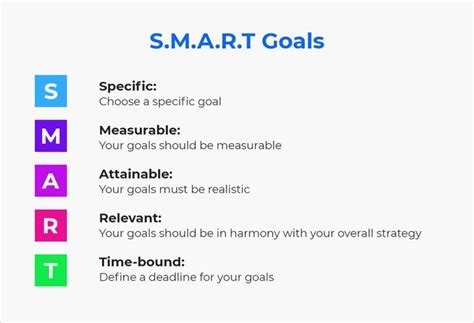Setting goals is essential for personal and professional growth, but simply having a goal isn’t enough. Effective goal-setting requires a structured approach, and this is where SMART goals come into play. SMART, an acronym for Specific, Measurable, Achievable, Relevant, and Time-bound, provides a clear framework to define and achieve objectives with precision and purpose. In this article, we will explore the definition and origins of SMART goals, break down each component of the acronym, and discuss their importance in effective goal setting. By understanding these elements, you can avoid common pitfalls and apply SMART goals to real-life scenarios, driving meaningful progress in your aspirations.
weninsure.xyz invites you to explore this topic thoroughly.
1. Definition and Origin of SMART Goals
SMART goals originated in the early 1980s as a tool to enhance the clarity and effectiveness of goal setting in both business and personal development. The concept was first introduced by George T. Doran in his 1981 paper titled “There’s a S.M.A.R.T. Way to Write Management’s Goals and Objectives,” where he emphasized the need for goals to be clear and attainable.
The SMART framework was designed to address the common challenges people face when setting goals, such as vagueness, lack of focus, and unrealistic expectations. By breaking down goals into five key components—Specific, Measurable, Achievable, Relevant, and Time-bound—this method ensures that objectives are well-defined and actionable.
Over time, SMART goals have become a widely adopted practice in various fields, from corporate environments to personal development. Their structured approach provides a roadmap that helps individuals and organizations achieve success by setting clear, actionable, and realistic objectives. The continued relevance of SMART goals highlights their effectiveness in driving progress and achieving meaningful outcomes.
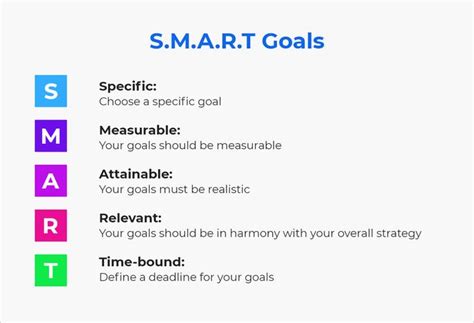
2. Breaking Down the SMART Acronym
The SMART acronym stands for Specific, Measurable, Achievable, Relevant, and Time-bound, each representing a critical element of effective goal-setting.
Specific: Goals should be clear and unambiguous. Instead of setting a vague objective like “improve fitness,” a specific goal would be “run three times a week for 30 minutes each session.” This clarity helps in understanding exactly what needs to be accomplished.
Measurable: A goal must include criteria for measuring progress. For instance, “increase sales by 10%” provides a tangible target to work towards, allowing for assessment and adjustments along the way.
Achievable: Goals should be realistic and attainable within your current capabilities and resources. Setting a goal that is challenging but possible ensures motivation remains high and reduces the risk of frustration.
Relevant: The goal should align with broader life or career objectives. It should matter to you and contribute to your long-term aspirations.
Time-bound: Every goal needs a deadline to create a sense of urgency and prioritize efforts. For example, “complete the project by the end of the month” sets a clear timeline, driving consistent progress.
Together, these components form a solid foundation for setting and achieving meaningful goals.
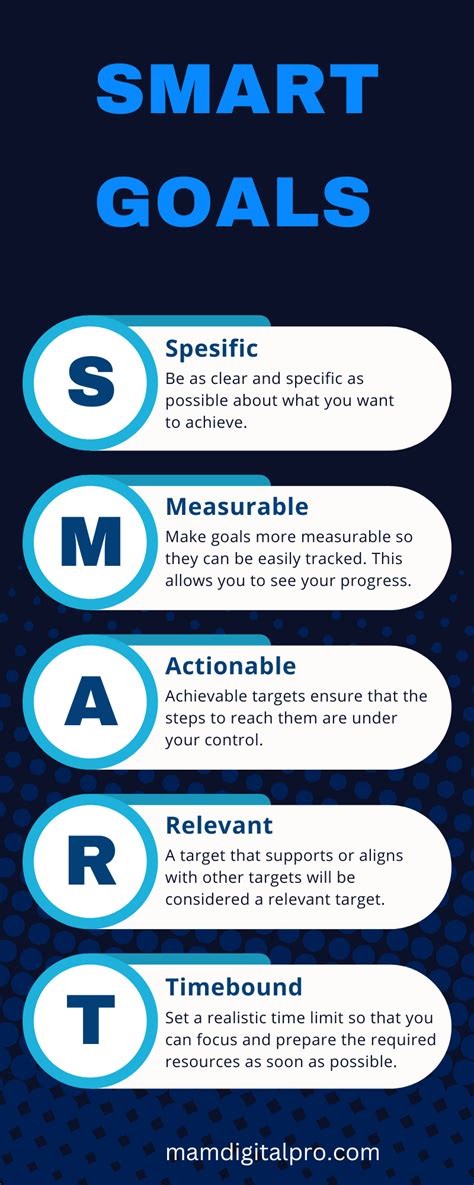
3. Importance of Each SMART Component
Each component of the SMART framework plays a vital role in ensuring that goals are well-structured and attainable.
Specific goals provide clarity, reducing confusion and making it easier to focus on what truly matters. Without specificity, goals can become overwhelming or too broad to tackle effectively.
Measurable goals enable you to track progress and stay motivated. By having quantifiable milestones, you can celebrate small victories and make necessary adjustments to stay on course.
Achievable goals help maintain motivation by setting realistic expectations. This prevents burnout from attempting something too far out of reach while still encouraging growth and challenge.
Relevant goals ensure alignment with your broader objectives, making sure that your efforts contribute meaningfully to your overall aspirations.
Time-bound goals create urgency, encouraging consistent action and preventing procrastination. A clear timeline keeps you focused and accountable, driving sustained effort until the goal is achieved.
Together, these elements maximize the effectiveness of your goal-setting strategy.
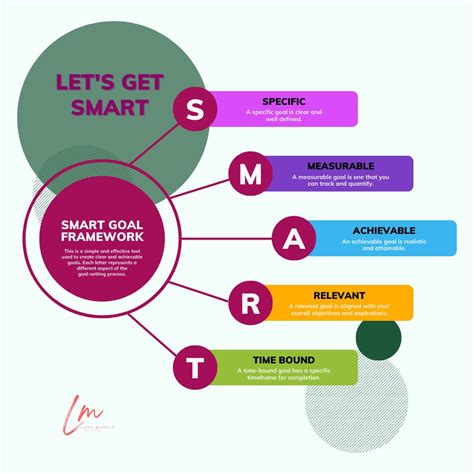
4. Common Pitfalls and How to Avoid Them
Despite the effectiveness of the SMART framework, certain pitfalls can hinder the goal-setting process if not carefully managed.
One common pitfall is setting goals that are too vague. Even with the SMART criteria, goals can sometimes lack clarity, leading to confusion or lack of direction. To avoid this, ensure that each goal is as specific as possible, leaving no room for ambiguity.
Another issue is overestimating what is achievable. While it’s important to challenge yourself, setting goals that are too difficult can lead to frustration and burnout. To prevent this, assess your resources and capabilities honestly and adjust your goals accordingly.
Ignoring the relevance of a goal is another common mistake. If a goal doesn’t align with your broader objectives, it can lead to wasted effort and disengagement. Always ensure that each goal is meaningful and contributes to your long-term aspirations.
Finally, failing to set a clear deadline can cause procrastination. Without a time-bound element, there’s no urgency to act, leading to delays or even abandonment of the goal. To avoid this, establish firm timelines and regularly review your progress.
By being aware of these pitfalls and taking proactive steps, you can ensure your goals remain on track.
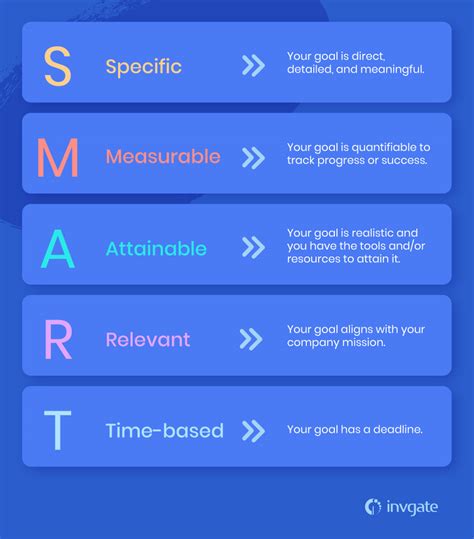
5. Real-Life Examples and Applications
SMART goals can be applied across various aspects of life, from personal development to professional growth. Here are a few real-life examples to illustrate their effectiveness:
Personal Fitness: Instead of vaguely deciding to “get in shape,” a SMART goal would be, “Lose 10 pounds in three months by exercising four times a week and following a balanced diet.” This goal is specific, measurable, achievable, relevant, and time-bound, making it easier to follow and track progress.
Career Advancement: A professional might set a goal to “Obtain a project management certification within six months by dedicating two hours every evening to study.” This goal aligns with the SMART criteria, helping the individual stay focused and motivated.
Financial Planning: To improve financial health, one could set a goal like, “Save $5,000 for an emergency fund within one year by setting aside $417 per month.” This SMART goal provides clear direction and helps maintain consistent effort toward a significant financial milestone.
By applying the SMART framework, these examples demonstrate how clear, structured goals can lead to tangible achievements in various areas of life.

SMART goals provide a powerful framework for setting and achieving meaningful objectives in both personal and professional life. By ensuring that goals are Specific, Measurable, Achievable, Relevant, and Time-bound, you can avoid common pitfalls and maintain focus and motivation. Whether improving fitness, advancing in your career, or reaching financial milestones, the SMART approach helps turn aspirations into actionable, successful outcomes.
weninsure.xyz

